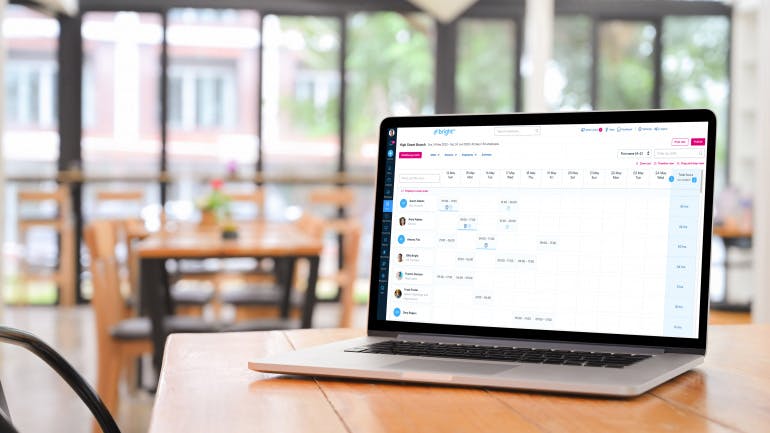First published on Thursday, November 10, 2022
Last updated on Wednesday, December 4, 2024
Jump to section
Let’s talk about split shifts. Whether you’re a seasoned employer or new to the game, scheduling employees can sometimes feel like a puzzle. Among the various scheduling styles out there, split shifts stand out.
If you’re wondering what they are, why they exist, and how to manage them efficiently, especially with HR software on your side, you’ve come to the right place.
What is a split shift?
In simple terms, a split shift is when an employee’s workday is broken up into two or more separate chunks. They work a few hours, take a significant break, and then return for another round later in the day.
Unlike your typical 9-to-5, a split shift might look something like this: a worker starts at 8 am, takes a break from noon to 4 pm, and then finishes the day from 4 pm to 8 pm. So, by this rule a traditional shift with a one-hour lunch break is not considered a split shift.
Examples of split shifts
A restaurant employee may work from 11 am to 2 pm for the lunch rush and return for the dinner rush from 6 pm to 10 pm.
Call centre staff could work from 7 am to 11 am, then again from 3 pm to 7 pm to give employees recovery time between phone calls.
Bus drivers might cover school pick-ups in the morning from 7 am to 9 am and again in the afternoon from 2 pm to 4 pm.
Why should you use split shifts?
Now, you might be wondering, why would I want to break up someone’s workday? The answer: it’s all about flexibility and efficiency.
Here’s why some employers opt for split shifts:
Matching staffing with demand
Imagine you run a restaurant. Lunchtime is booming, but mid-afternoon things quiet down, only to pick up again at dinner.
Instead of keeping staff around during slow periods, split shifts allow you to schedule your employees when you need them most—during those busy spikes.
Cost-effectiveness
Split shifts can help you manage labour costs. By scheduling workers only during high-traffic times, you’re not paying for idle hours when business is slow.
Employee flexibility
Some employees may actually prefer split shifts. It allows them to run errands, take care of personal matters, or even work a second job in between.
Of course, not everyone loves this schedule, but for the right person, it can be a perk.
How to manage split shifts like a pro
Now that you know why split shifts might make sense, let’s get into the nitty-gritty of managing them. Spoiler alert: It doesn’t have to be a headache. In fact, with the right HR software, you’ll look like a scheduling genius.
Here’s how to manage split shifts like a pro—with a little help from HR software:
Use a shift and rota feature to plan split shifts easily
One of the best features of HR software—the ability to create and manage rotas with just a few clicks.
Most HR software platforms come with robust shift planning tools that allow you to easily schedule split shifts. These tools let you break up an employee’s day into separate blocks, assigning work periods and breaks seamlessly.
You can also drag and drop shifts into place, set recurring rotas, and assign specific workers to the times that best suit their availability.
No more spreadsheets or manual adjustments—HR software automates it all, ensuring that shifts align with peak demand times without overloading your staff.
Plus, with real-time scheduling features, employees can see their shifts immediately, making it easier for them to plan their day around their work breaks. Need to make last-minute changes? No problem—just tweak the rota in the system, and everyone gets updated instantly. It’s all about flexibility.
Communicate clearly and early
Split shifts require careful communication with your employees. You can’t just spring it on them last-minute. Your team needs to know when they’re working, how long they’ll be off, and when they’re expected back.
HR software can make this a breeze by sending automatic notifications to employees about their upcoming shifts, eliminating any confusion.
Use HR software to track hours
Managing multiple start and end times for one workday can get tricky. Thankfully, HR software does the heavy lifting with clocking in and out.
It can automatically track hours worked during each segment of the shift, ensuring no one is underpaid or accidentally scheduled overtime.
Plus, it keeps you compliant with your provincial l employment standards, so you’re not caught off guard by any working hour issues down the line.
Optimise your workforce
With HR software, you can easily identify trends and adjust staffing levels accordingly. For example, if you notice that business dips between 2 pm and 4 pm, you can set up split shifts that perfectly align with your needs.
This saves you from overstaffing during slow periods or scrambling to find help when things get busy.
Split shift compliance: What to keep in mind
Before you go scheduling split shifts left and right, it’s important to understand the legal side of things. In the UK, there are spesific employment laws you must follow.
For example, under the Working Time Regulations 1998, you must give employees:
A rest period of 11 consecutive hours in each 24 hour period
A 20 minute break if they work more than 6 hours—the split shift break doesn't count
Staying on top of these regulations and having access to employment law experts is key to avoiding any unwanted surprises like costly fines and penalties.
Split shifts can be a game-changer
So, are split shifts right for your team? Take a closer look at your staffing needs and don’t be afraid to experiment. Just remember to communicate clearly, stay compliant, and lean on tech to keep things running like a well-oiled machine.
In the right situation, split shifts can help you optimise your workforce, manage costs, and keep operations running smoothly during peak times.
And with an efficient HR software in your toolkit, managing split shifts becomes a whole lot easier—giving you more time to focus on what really matters: growing your business and keeping your employees happy.
If you’re unsure how to implement split shifts in your business or need advice on creating a schedule that works for you and your employees, BrightHR can help.
Contact us on 0800 470 2432 to get tailored advice on employment issues, or book a demo to see how our service works.










